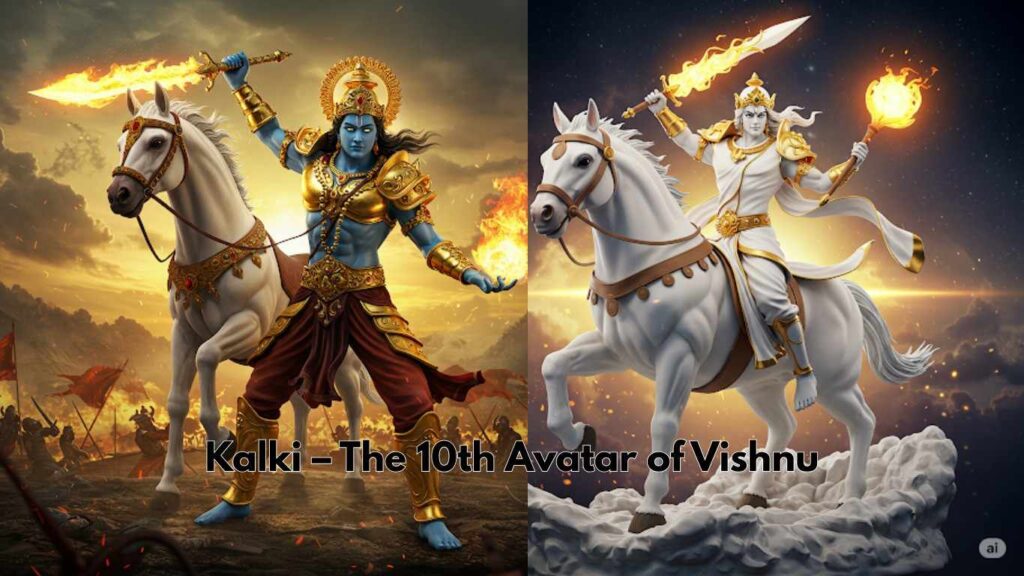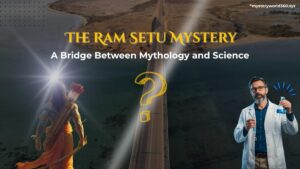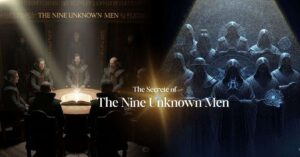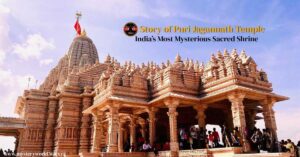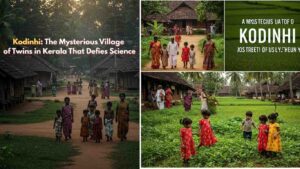Kalki – The 10th Avatar of Vishnu: The Future Warrior of Dharma

Kalki – The 10th Avatar of Vishnu
(Kalki – The 10th Avatar of Vishnu) As the Preserver in the Holy Trinity (Trimurti) of Hinduism—Brahma the Creator, Vishnu the Preserver, and Shiva the Destroyer—Vishnu incarnates whenever Dharma (righteousness) is threatened. These incarnations are known as the Dashavatara, or ten avatars of Vishnu. While nine of these avatars have already manifested throughout the ages, the tenth—Kalki – The 10th Avatar of Vishnu, the harbinger of the future—is yet to come. This future avatar will mark the end of the current era, Kali Yuga, and restore righteousness on Earth.
This comprehensive article explores the prophecy, mythology, symbolism, and cultural significance of Kalki – The 10th Avatar of Vishnu, the 10th avatar of Vishnu, delving deep into scriptural references, philosophical interpretations, and the mystery surrounding his awaited arrival.
Chapter 1: The Concept of Dashavatara
In the vast and spiritually rich traditions of Hinduism, the Dashavatara holds a central place. It refers to the ten divine incarnations of Lord Vishnu, the Preserver in the Hindu trinity, who descends to Earth in various forms to restore cosmic order. Each avatar represents a unique phase in the spiritual evolution of the universe, carrying deep philosophical and symbolic meaning.
What is Dashavatara?
The word “Dashavatara” is derived from Sanskrit, where “Dasha” means ten and “Avatara” means incarnation. Thus, Dashavatara translates to “ten incarnations.” According to Hindu scriptures, these ten avatars appear in different yugas (epochs) to combat evil, uphold dharma (cosmic law and righteousness), and guide humanity.
The Ten Avatars of Vishnu – Dashavatara List
- Matsya (The Fish)
- Symbolism: Protection and salvation
- Kurma (The Tortoise)
- Symbolism: Support and stability
- In the second avatar, Vishnu took the form of a tortoise to help the gods and demons churn the cosmic ocean (Samudra Manthan) for the nectar of immortality.
- Varaha (The Boar)
- Symbolism: Earth’s preservation
- Varaha, the boar incarnation, rescued the Earth (personified as the goddess Bhudevi) from the demon Hiranyaksha who had submerged it under cosmic waters.
- Narasimha (The Man-Lion)
- Symbolism: Divine justice and protection
- Vishnu took this fierce form—half-man, half-lion—to kill the demon Hiranyakashipu and protect his devout son, Prahlada, thereby upholding faith over tyranny.
- Vamana (The Dwarf)
- Symbolism: Humility and cosmic balance
- As a Brahmin dwarf, Vamana approached the demon king Bali and cleverly reclaimed the heavens by covering the universe in three strides.
- Parashurama (The Warrior with an Axe)
- Symbolism: Justice and cleansing of corruption
- Parashurama appeared to destroy corrupt and tyrannical Kshatriya rulers and restore order through divine retribution.
- Rama (The Prince of Ayodhya)
- Symbolism: Ideal man and dharma in action
- Krishna (The Divine Statesman and Teacher)
- Symbolism: Love, wisdom, and divine play (leela)
- Krishna played a pivotal role in the Mahabharata, offering the Bhagavad Gita’s teachings, and is celebrated for his divine charm, diplomacy, and teachings.
- Buddha (The Enlightened One)
- Symbolism: Compassion and inner awakening
- Some traditions recognize Gautama Buddha as an avatar of Vishnu, sent to reform ritualistic practices and emphasize non-violence and meditation.
- Kalki (The Future Avatar) Kalki – The 10th Avatar of Vishnu
- Kalki – The 10th Avatar of Vishnu, the yet-to-appear tenth avatar, is prophesied to arrive on a white horse at the end of Kali Yuga to destroy evil and restore dharma.
Philosophical Significance of Dashavatara
The Dashavatara is more than mythology; it is a spiritual framework that mirrors the evolution of life and consciousnessMatsya (fish) – aquatic life
- Kurma (amphibian) – amphibians
- Varaha (boar) – terrestrial mammals
- Narasimha (half-animal, half-human) – early humanoids
- Vamana (dwarf human) – early humans
Dashavatara in Art and Culture
The Dashavatara theme has inspired countless forms of Indian art, temple architecture, classical dance, music, and literature. Temples in South India, such as the ones in Tamil Nadu and Andhra Pradesh, feature stunning depictions of the ten avatars. Traditional dance forms like Bharatanatyam and Kathakali often include Dashavatara-based performances.
Regional Interpretations and Variations
While the most widely accepted version includes Buddha as the ninth avatar, some Vaishnavite traditions replace him with Balarama, Krishna’s elder brotherDashavatara and Dharma
Each avatar of Vishnu emerges in response to a specific form of adharma (unrighteousness) prevailing during a particular age. Through divine intervention, Vishnu re-establishes dharma, reaffirming the idea that cosmic justice is inevitable, even if delayed. This cyclical theme of rise, fall, and restoration permeates Hindu philosophy and inspires hope in times of turmoil.
Why Dashavatara Still Matters Today
The Dashavatara story is not confined to ancient texts; it carries powerful modern-day relevance. Whether it’s Krishna’s wisdom during crises or Rama’s adherence to principles, each avatar teaches lessons in resilience, righteousness, and spiritual evolution.
In a world grappling with moral ambiguity, environmental degradation, and social unrest, the message of Dashavatara—that divinity will intervene when humanity falters—remains deeply reassuring.

1.1 Overview of Dashavatara
- Matsya (Fish) – Rescued the first man and sacred scriptures from a great flood.

lord vishnu Matsya avatara Matsya (Fish) – Rescued the first man and sacred scriptures from a great flood
- Kurma (Turtle) – Supported Mount Mandara during the churning of the ocean.
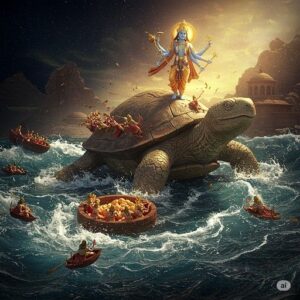
Kurma (Turtle) – Supported Mount Mandara during the churning of the ocean: In his second avatar, Lord Vishnu took the form of a giant turtle, Kurma, to support Mount Mandara on his back during the Samudra Manthan (churning of the ocean). Kurma symbolizes strength, stability, and divine support in times of cosmic upheaval.
3.Varahavatara is the third avatar of Lord Vishnu in the Dashavatara (the ten primary incarnations of Vishnu) in Hindu. 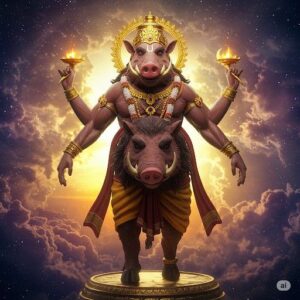
Varahavatara is the third avatar of Lord Vishnu in the Dashavatara, where he incarnates as a powerful boar to rescue the Earth (Bhudevi) from the cosmic ocean after it was submerged by the demon Hiranyaksha. This form symbolizes the victory of good over evil and the restoration of balance in the universe.
4. Narasimha (Half-man, Half-lion) – Destroyed the tyrant Hiranyakashipu.

Manifesting at twilight, in a form that was neither man nor beast, Narasimha emerged from a pillar and killed Hiranyakashipu without violating the boon he had received, symbolizing the victory of divine justice over arrogance and evil.
5. Vamana (Dwarf) – Subdued the demon king Bali through a divine trick.
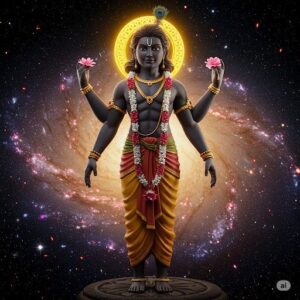
Vamana (Dwarf) – The fifth avatar of Vishnu, Vamana appeared as a humble Brahmin dwarf to subdue the demon king Bali.
6. Parashurama (Warrior Priest) – Vanquished corrupt Kshatriya kings.

Parashurama (Warrior Priest) – The sixth avatar of Vishnu, Parashurama was a fierce Brahmin warrior who wielded an axe to rid the world of corrupt Kshatriya kings and restore dharma.
7. Rama (Prince of Ayodhya) – The hero of the Ramayana who defeated Ravana.

8. Krishna, often called the Divine Cowherd, is the eighth avatar of Lord Vishnu in the Dashavatara (ten principal avatars) of Hinduism.
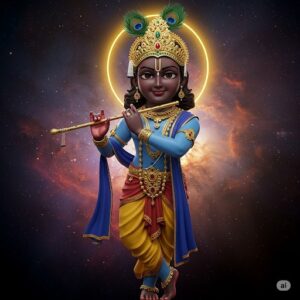
Krishna, the Divine Cowherd, is the eighth avatar of Lord Vishnu in the Dashavatara, known for his divine play (leela), wisdom, and role in the Mahabharata.
9. Buddha, referred to as “The Enlightened One”, is considered the ninth avatar of Vishnu in certain Hindu traditions—particularly in the Dashavatara list followed by Vaishnavism.

Buddha, known as “The Enlightened One”, is revered as the ninth avatar of Vishnu in some Hindu traditions, especially within the Vaishnavite Dashavatara list.
The tenth avatar, Kalki – The 10th Avatar of Vishnu, remains shrouded in mystery—awaited but unseen.
Chapter 2: Kali Yuga – The Age of Darkness
2.1 The Yuga Cycle
Hindu cosmology divides time into four Yugas:
-
Satya Yuga (Golden Age)
In Hindu cosmology, time is viewed as cyclical, flowing through a repeating sequence of four great ages known as the Yuga Cycle: Satya Yuga, Treta Yuga, Dvapara Yuga, and Kali Yuga. Among these, Satya Yuga—also called the Golden Age—is considered the first and most spiritually elevated age. It is an era of pure truth, divine harmony, and moral perfection.
What is Satya Yuga?
Satya Yuga, derived from the Sanskrit word “Satya”, meaning truth, is the longest and most righteous of the four yugas. It is also called Krita Yuga, signifying a time when the world operated purely according to dharma (cosmic law and virtue). This age is marked by peace, prosperity, longevity, and spiritual enlightenment.
According to the Hindu Puranas, the duration of Satya Yuga is 1,728,000 human years, and it is characterized by the dominance of Sattva guna (purity and harmony).
Characteristics of Satya Yuga
- Universal Dharma: Truth and righteousness prevailed everywhere. People followed Sanatana Dharma naturally without external enforcement.
- Spiritual Enlightenment: Meditation, yoga, and inner realization were central. Humans were spiritually advanced and deeply connected to the divine.
- No Crime or Suffering: There was no violence, disease, greed, or dishonesty. Human beings lived long, healthy lives in peace.
- Equality: There was no discrimination based on caste, creed, or wealth
- Divine Presence: The presence of the divine was directly experienced by sages and common people alike.
- Four Pillars of Dharma Intact: Dharma in this age rested firmly on all four legs—truth, compassion, austerity, and cleanliness—symbolizing complete moral and spiritual balance.
Satya Yuga and Human Civilization
There was no need for kings or governments because everyone inherently followed dharma. Food was obtained effortlessly from nature, and desires were minimal. Temples and rituals were unnecessary as the divine was realized within.
According to Scriptures:
- People lived for 100,000 years without disease or sorrow.
- There was no division in society; everyone was a Brahmana by virtue, not birth.
- Vedas were one and undivided, and all knowledge was internally realized
Great Figures of Satya Yuga
- Svayambhuva Manu – The first Manu and progenitor of mankind.
- Rishis like Sanaka, Sanatana, Sanandana, and Sanatkumara – Eternal sages who taught spiritual knowledge.
- Lord Vishnu took the Matsya Avatar in this Yuga to save the Vedas and humanity from the great flood.
- Hamsa Avatar, a lesser-known divine form, is also believed to have appeared during this time to deliver supreme knowledge to sages.
Symbolism of Satya Yuga
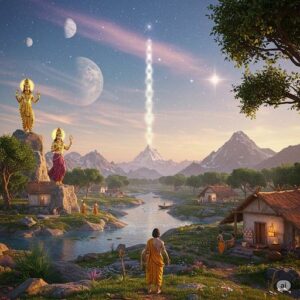
Satya Yuga is symbolized by light, purity, and gold. It is the age of the highest human potential, where consciousness is fully awakened and aligned with the divine. It serves as the ideal that all other yugas fall short of and try to return to.
The progression of yugas is often compared to the cycle of a day:
- Satya Yuga: Morning – freshness, clarity, and peace.
- Dvapara Yuga: Evening – duality, struggle.
- Kali Yuga: Night – darkness and ignorance.
Satya Yuga in the Cycle of Time
According to Hindu timekeeping:
- A full Yuga Cycle = 4,320,000 years
- Satya Yuga = 1,728,000 years
- It is followed by Treta Yuga (1,296,000 years), Dvapara Yuga (864,000 years), and Kali Yuga (432,000 years)
Each Yuga sees a gradual decline in dharma:
- Satya Yuga – 100% dharma
- Treta Yuga – 75% dharma
- Dvapara Yuga – 50% dharma
- Kali Yuga – 25% dharma
After Kali Yuga ends, the cycle restarts with a new Satya Yuga, heralded by the arrival of Kalki – The 10th Avatar of Vishnu, the 10th avatar of Vishnu, who will purify the world and restore righteousness.
Relevance of Satya Yuga Today
While we currently live in Kali Yuga, the age of darkness and moral decline, the concept of Satya Yuga serves as a guiding light. It reminds humanity of its divine potential and encourages us to uphold truth, compassion, and dharma in our daily lives, no matter the age we live in.
Modern yogic and spiritual movements often aim to awaken the Satya Yuga consciousness within individuals—promoting inner purity, mindfulness, and alignment with universal truth.
- Treta Yuga (Silver Age)
Treta Yuga – The Silver Age of Hindu Cosmology
What is Treta Yuga?

The term “Treta Yuga” comes from the Sanskrit word “Treta,” meaning “three.” It is so named because during this era, three out of the four pillars of dharma (truth, compassion, penance, and charity) remain intact. In Hindu belief, the world operates on these four pillars, and with each successive Yuga, one pillar is lost, leading to a progressive decline in morality and spiritual awareness.
- Satya Yuga (Golden Age)
- Treta Yuga (Silver Age)
- Dvapara Yuga (Bronze Age)
- Kali Yuga (Iron Age)
Duration of Treta Yuga
According to Hindu scriptures, especially the Puranas:
- Treta Yuga lasts 1,296,000 human years.
- It is preceded by a Sandhya (dawn) of 100,000 years and followed by a Sandhyansha (dusk) of 100,000 years.
- The total span, including transition periods, is 1,296,000 years.
This Yuga is four times the length of the current Kali Yuga, highlighting the gradual elongation and purification of time as we go back in the cosmic cycle.
Characteristics of Treta Yuga
1. Decline of Dharma
In Treta Yuga, dharma stands on three legs (instead of four as in Satya Yuga). While truth and morality are still practiced, ego, desire, and ambition begin to appear in society. Rituals (yajnas) and sacrifices become prominent, and people start relying more on external practices than internal spiritual realization.
2. Emergence of Hierarchy
Social structure starts taking a more defined shape. The varna system (caste classification) becomes more pronounced. Kings and rulers govern the land with the guidance of sages and priests.
3. Technological and Cultural Growth
Though spiritual strength declines slightly, human civilization progresses in arts, science, medicine, and governance. Cities and kingdoms flourish. This is the era when humans begin mastering the use of fire, weaponry, agriculture, and early sciences.
4. Physical and Mental Prowess
Humans in Treta Yuga are still blessed with immense physical strength, mental clarity, and long lifespans—averaging thousands of years. They live in harmony with nature, and divine beings often interact with mortals.
Divine Incarnations in Treta Yuga
The Treta Yuga is particularly significant because two major avatars of Lord Vishnu appear in this age:
1. Vamana Avatar
- Vishnu incarnates as Vamana, the dwarf Brahmin, who humbles the demon king Mahabali and restores balance by reclaiming the heavens for the gods.
- This avatar emphasizes humility, divine strategy, and the control of ego.
2. Rama Avatar
- The seventh and most celebrated avatar of Vishnu, Lord Rama, appears in Treta Yuga.
- His story is narrated in the Ramayana, one of the two great Indian epics.
- Rama embodies dharma, virtue, compassion, and kingship, and his reign is considered the ideal example of righteous governance (Rama Rajya).
The Ramayana – The Epic of Treta Yuga
- Rama’s exile into the forest
- The abduction of Sita by Ravana
- The great war between Rama and Ravana in Lanka
The Ramayana not only serves as a religious scripture but also as a moral and philosophical guidebook for life.
Symbolism of Treta Yuga
While divine influence is still strong, humans begin to face challenges and tests of morality. This age reflects the importance of making choices, exercising free will, and taking responsibility for one’s actions.
Spiritual Practices of Treta Yuga
Unlike the Satya Yuga, where meditation was the primary mode of worship, in Treta Yuga, yajnas (fire sacrifices) become the dominant practice. Devotees invoke deities through rituals, chants, and offerings to maintain cosmic balance.
Treta Yuga vs. Other Yugas
| Yuga | Dharma Pillars | Duration (human years) | Key Avatar(s) | Spiritual Practice |
| Satya Yuga | 4 | 1,728,000 | None (divine age) | Meditation (Tapas) |
| Treta Yuga | 3 | 1,296,000 | Vamana, Rama | Yajna (Sacrifice) |
| Dvapara Yuga | 2 | 864,000 | Krishna, Balarama | Worship (Temple-based) |
| Kali Yuga | 1 | 432,000 | Kalki (future avatar) | Nama Japa (Chanting) |
Lessons from Treta Yuga
- Dharma is delicate: Even in an age of power and prosperity, slight deviations in dharma can lead to great conflicts, as seen in the Ramayana.
- Divine will guides humanity: Through avatars like Vamana and Rama, Treta Yuga reinforces the Hindu belief that the Divine always intervenes when righteousness is at stake.
Is Treta Yuga Still Relevant?
While we are currently believed to be in Kali Yuga, the stories and principles of Treta Yuga remain deeply relevant. They teach us about moral values, leadership, familial responsibility, and the eternal struggle between good and evil.
In a world that often seems chaotic and unjust, the ideals of Treta Yuga offer guidance and hope—a reminder that righteousness, though challenged, will ultimately prevail.
Dvapara Yuga (Bronze Age) 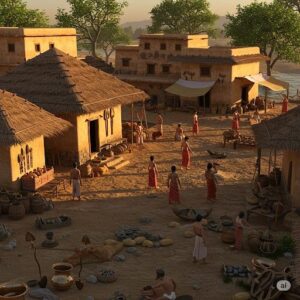
Dvapara Yuga (Bronze Age) – The Third Epoch of Hindu Cosmology
In the vast cycle of Hindu cosmology, time is divided into four repeating ages, or yugas: Satya Yuga, Treta Yuga, Dvapara Yuga, and Kali Yuga. Among these, Dvapara Yuga, the third in sequence, is a significant transitional phase. It represents a decline from the virtues of the earlier ages and a precursor to the moral and spiritual deterioration of the Kali Yuga. Often referred to as the Bronze Age in symbolic terms, the Dvapara Yuga holds deep spiritual, mythological, and philosophical significance.
Meaning and Duration of Dvapara Yuga
The term Dvapara in Sanskrit means “third” or “after the second.” It denotes the third age in the Chatur Yuga cycle. In Hindu time calculation:
- Duration of Dvapara Yuga: 864,000 human years
- It is half as long as the Satya Yuga and two-thirds the length of Treta Yuga.
- The age is divided into periods of rise and decline, with righteousness (dharma) sustained on only two legs (as compared to four in Satya Yuga).
Characteristics of Dvapara Yuga
While it still retains a considerable degree of virtue, it also sees a significant rise in human flaws.
Key Features:
- Dharma Declines: Dharma stands on two legs, indicating that truth, virtue, and righteousness have diminished by half.
- Increased Conflict: Greed, jealousy, and ambition grow stronger. Kings wage wars more frequently.
- Structured Society: Castes (varnas) become more rigid, and rituals and formal worship practices become widespread.
- Rise of Duality: Unlike the absolute truth of Satya Yuga, Dvapara Yuga is the age of duality—right and wrong are more often confused or debated.
- Divine Incarnations: This is the age when Lord Krishna, the eighth avatar of Vishnu, incarnated and played a crucial role in guiding humanity.
Dvapara Yuga and the Mahabharata
The most significant spiritual and historical event of Dvapara Yuga is the Mahabharata War, which took place toward the end of the age Lord Krishna’s Role:
- Krishna served as the charioteer and guide to Arjuna.
Spiritual Life in Dvapara Yuga
In this age, spiritual practice becomes more complex:
- Yajnas (Sacrificial rituals) became prominent.
- Temple worship and idol veneration gained importance.
- Mantra chanting and scriptural study were widely practiced.
- The Vedas were divided into four parts—Rigveda, Samaveda, Yajurveda, and Atharvaveda—for easier understanding due to the declining intellectual capacity of humanity.
Decline into Kali Yuga
As Dvapara Yuga ends, dharma continues to diminish. The death of Krishna marks the symbolic and literal end of this epoch and the beginning of the Kali Yuga, the darkest age.
- Kali Yuga begins in 3102 BCE, according to Hindu tradition.
- The transition marks the loss of divine presence and a full plunge into spiritual ignorance, materialism, and chaos.
Symbolism of Dvapara Yuga (Bronze Age)
The term “Bronze Age” in Hindu symbolism doesn’t refer to historical metallurgy but rather to the spiritual quality of the age. It denotes:
- The intermediate state between divine purity (golden age) and complete moral decay (iron age).
- A time of complexity, conflict, and choice.
- A period where human beings are tested—with divine guidance still present but harder to access.
Teachings and Lessons from Dvapara Yuga
Even though the age is marred by conflict, it offers rich spiritual lessons:
- The Bhagavad Gita’s message transcends time and teaches humanity how to live a life of purpose and inner stability.
- Faith in divine guidance, as exemplified by Krishna, is vital for spiritual evolution.
Dvapara Yuga in the Yuga Cycle
| Yuga | Dharma Level | Duration (Human Years) | Dominant Qualities |
| Satya Yuga | 4 legs | 1,728,000 | Truth, purity, virtue |
| Treta Yuga | 3 legs | 1,296,000 | Morality, sacrifice |
| Dvapara Yuga | 2 legs | 864,000 | Duality, rituals, structured worship |
| Kali Yuga | 1 leg | 432,000 | Ignorance, conflict, spiritual darkness |
Kali Yuga (Iron Age)

Kali Yuga – The Iron Age of Darkness and Decline
In the grand cycles of time described in Hindu cosmology, Kali Yuga is the final and most turbulent of the four cosmic ages, or Yugas. It is often referred to as the Iron Age, a period marked by moral decline, spiritual degradation, conflict, and the rise of materialism. The concept of Kali Yuga is not merely symbolic—it serves as a profound commentary on the cyclical nature of human civilization and the importance of dharma in maintaining cosmic balance.
What is Kali Yuga?
Kali Yuga, derived from the Sanskrit word Kali (not to be confused with the goddess Kali), refers to strife, discord, or quarrel. These four Yugas together form one Mahayuga, which spans approximately 4.32 million years.
- Kali Yuga Duration: 432,000 years
- Current Year in Kali Yuga: As of 2025 CE, approximately 5127 years of Kali Yuga have passed
Characteristics of Kali Yuga
The scriptures, especially the Puranas, such as the Vishnu Purana and Bhagavata Purana, provide vivid descriptions of the Kali Yuga’s traits:
- Decline of Dharma: Only one-quarter of righteousness (dharma) remains, and even that diminishes over time.
- Moral Corruption: Truth, compassion, and self-discipline decline. Hypocrisy and deceit dominate society.
- Rise of Materialism: Wealth and status become the sole criteria for respect, while spirituality is disregarded.
- Degeneration of Relationships: Family bonds weaken; loyalty and love give way to selfish motives.
- Social Injustice: Leaders are corrupt, justice is sold, and power lies in the hands of the unrighteous.
- Environmental Decay: Natural disasters and ecological imbalance increase.
- Spiritual Confusion: False gurus and misleading doctrines spread, leading people astray from the true path.
Kali Yuga in Hindu Scriptures
Bhagavata Purana
In Srimad Bhagavatam (12.2), Kali Yuga is portrayed as an era where:
Mahabharata
The Mahabharata describes the beginning of Kali Yuga as starting right after the departure of Lord Krishna from Earth. His departure marked the end of Dvapara Yuga and the dawn of this age of darkness.
Spiritual Significance of Kali Yuga
While Kali Yuga is often viewed with pessimism, it also holds deep spiritual opportunities:
- Easiest Path to Liberation: According to Hindu belief, Nama Sankirtana (chanting the name of the Lord) is the most effective spiritual practice in this Yuga.
- Krishna’s Assurance: In the Bhagavad Gita, Krishna assures devotees that those who surrender to him will be protected even in the darkest times.
Kalki Avatar and the End of Kali Yuga
His mission is to destroy evil, purge the world of unrighteousness, and herald the return of Satya Yuga, the Golden Age.
This cyclical concept symbolizes that no matter how dark times may seem, divine intervention and spiritual renewal are inevitable.
Symbolism of Iron Age (Kali Yuga)
- Dvapara Yuga (Bronze Age) – Dharma is halved
- Kali Yuga (Iron Age) – Dharma stands on one leg, barely surviving
It represents the age where the inner strength of humanity is tested most severely.
Many scholars and spiritual thinkers believe that the symptoms of Kali Yuga are evident in our current world:
- Political corruption
- Religious hypocrisy
- Technological advancement but moral decline
- Environmental disasters
- Mental health crises and disconnection
These parallels between scriptural predictions and contemporary life lead many to believe we are deeply embedded in Kali Yuga.
How to Survive Spiritually in Kali Yuga
The scriptures prescribe several ways to maintain spiritual strength during Kali Yuga:
- Chanting God’s Name (Nama Japa) – Especially names like Hare Krishna, Rama, or Vishnu.
- Association with Saints – Spending time with spiritually evolved beings.
- Study of Scriptures – Engaging with texts like the Bhagavad Gita, Ramayana, and Puranas.
- Compassion and Charity – Practicing kindness and helping those in need.
Yuga Cycle – The Bigger Picture
According to Hindu cosmology, time moves in cycles:
- Satya Yuga (1,728,000 years)
- Treta Yuga (1,296,000 years)
- Dvapara Yuga (864,000 years)
- Kali Yuga (432,000 years)
One complete cycle (Mahayuga) = 4.32 million years
This grand vision reflects the Hindu understanding of time as cyclical, not linear—a cycle of birth, decay, destruction, and rebirth.
2.2 Characteristics of Kali Yuga
According to scriptures like the Vishnu Purana and the Bhagavata Purana, Kali Yuga is characterized by:
- Decline of truth and righteousness
- Increase in greed, hatred, and ego
- Breakdown of family structures
- Corruption in governance
- Perversion of religious institutions
- Widespread ignorance of dharma
It is within this degenerative cycle that Kalki – The 10th Avatar of Vishnu is prophesied to appear, riding a white horse, wielding a blazing sword, and vanquishing evil.
Chapter 3: Scriptural References to Kalki – The 10th Avatar of Vishnu
3.1 The Vishnu Purana
The Vishnu Purana provides detailed prophecies about Kalki – The 10th Avatar of Vishnu:
3.2 The Srimad Bhagavatam
In Canto 12, Chapter 2, the Srimad Bhagavatam states:
3.3 Other Texts
Mentions of Kalki – The 10th Avatar of Vishnu also appear in:
- Mahabharata (Vanaparva)
- Bhavishya Purana
- Agni Purana
- Garuda Purana
All these texts predict a catastrophic yet transformative era, with Kalki emerging as the savior.
Chapter 4: Kalki’s Birth and Symbolism
4.1 The Prophesied Birth
Kalki is foretold to be born in Shambhala, a mythical village in India. His father will be a Brahmin named Vishnuyasha, and his mother Sumati. His birth will occur at the darkest point of Kali Yuga, when humanity has almost lost its connection to righteousness.
4.2 Symbolic Representation
Each element of Kalki’s persona is symbolic:
- White Horse (Devadatta) – Purity, speed, and divine power
- Flaming Sword – Destruction of evil, cutting through ignorance
- Armor and Warrior Attire – Readiness to battle adharma
- Four-Armed Form – Manifestation of divine omnipotence
Chapter 5: Kalki’s Role in Ending Kali Yuga
5.1 The War of the Ages
Kalki’s appearance will trigger a massive upheaval. Evil rulers, corrupt priests, immoral influencers, and tyrannical forces will be annihilated in a divine purge. Kalki will not engage in passive reform but active and divine warfare.
5.2 Restoration of Dharma
Following this cosmic battle, Kalki will:
- Re-establish the Vedas
- Re-instate righteous rulers
- Enlighten spiritual leaders
- Restore societal balance
- Initiate a new Satya Yuga
Chapter 6: Kalki – The 10th Avatar of Vishnu in Popular Culture
6.1 Literature and Texts
Modern literature, novels, and short stories have reimagined Kalki as a superhero, revolutionary, or futuristic savior.
6.2 Kalki in Modern Media
From movies to television, Kalki has found representations as:
- A divine warrior in graphic novels
- An action hero in futuristic retellings
- A philosophical symbol in fiction
Notable Indian authors like Amish Tripathi and Ashwin Sanghi have explored Kalki themes in their works.
Chapter 7: Philosophical Interpretations
7.1 Symbol of Inner Transformation
Some scholars interpret Kalki – The 10th Avatar of Vishnu symbolically—as the inner destroyer of ignorance. The white horse represents divine energy, and the sword is the discerning intellect. Thus, Kalki’s arrival becomes a metaphor for spiritual awakening within individuals.
7.2 The Eternal Cycle
Kalki embodies the necessary destruction that precedes renewal.
Chapter 8: Kalki – The 10th Avatar of Vishnu and Other Faiths
8.1 Comparative Religion
Kalki – The 10th Avatar of Vishnu shares thematic similarities with:
- The Second Coming of Christ in Christianity
- Imam Mahdi in Islam
- Maitreya Buddha in Buddhism
- Saoshyant in Zoroastrianism
All these messianic figures are prophesied to appear at the end of a dark age to restore cosmic balance.
8.2 Universal Archetype
This cross-cultural alignment points to a universal archetype—a redeemer who emerges in crisis. Kalki – The 10th Avatar of Vishnu is the Indian embodiment of this universal hope.
Chapter 9: Mysteries of Shambhala
9.1 Is Shambhala Real?
Shambhala, the village where Kalki – The 10th Avatar of Vishnuis prophesied to be born, has remained a mystery. Some believe it lies in Uttarakhand or Himalayan regions, while others consider it a mythical spiritual realm.
9.2 Spiritual Significance
Kalki – The 10th Avatar of Vishnu’s emergence from this land suggests that he is not just physically powerful, but also spiritually supreme.
Chapter 10: The Wait for Kalki – The 10th Avatar of Vishnu
10.1 Signs of Arrival
- Climate change and environmental collapse
- Global moral degradation
- Collapse of governments and religions
- Rise of false prophets and pseudo-gurus
Many believe we are nearing this phase.
10.2 Is Kalki – The 10th Avatar of Vishnu Already Among Us?
Speculations abound that Kalki – The 10th Avatar of Vishnu may already be born, living in anonymity, awaiting divine timing. Some spiritual gurus claim to be Kalki – The 10th Avatar of Vishnu, but most are dismissed as impostors. The true Kalki, scriptures say, will be unmistakable.
Kalki – The 10th Avatar of Vishnu
The universe operates in cycles, and in Hinduism, these cycles are governed by the eternal principles of creation, preservation, and destruction. Among the ten major incarnations—known as the Dashavatara—the last and most awaited is Kalki – The 10th Avatar of Vishnu, the destroyer of darkness and restorer of Dharma.
Kalki – The 10th Avatar of Vishnu is not just another mythological figure. He represents a divine promise—that when the world sinks into corruption, chaos, and spiritual decay, a savior will rise. Let’s dive deep into the legend of Kalki – The 10th Avatar of Vishnu.
The Timeline: Yugas and the Age of Kali
- Kali Yuga – the age of darkness, corruption, and spiritual ignorance
We are currently living in Kali Yuga, which began after the death of Lord Krishna. It is said to last for 432,000 years, and we are over 5,000 years into it.
Scriptural References to Kalki – The 10th Avatar of Vishnu
Several Hindu scriptures reference Kalki – The 10th Avatar of Vishnu’s arrival:
- Bhagavata Purana (Skanda 12) describes Kalki – The 10th Avatar of Vishnu as a divine warrior born in the village of Shambhala to a Brahmin named Vishnuyasha.
Description and Symbols of Kalki – The 10th Avatar of Vishnu
Kalki – The 10th Avatar of Vishnuis portrayed as a radiant, formidable warrior, riding a white horse named Devadatta and wielding a flaming sword. His appearance is fierce yet divine, a beacon of justice in a world overrun by evil.
Symbols Associated with Kalki – The 10th Avatar of Vishnu:
| Symbol | Meaning |
| White Horse (Devadatta) | Purity, speed, power |
| Flaming Sword | Destruction of evil and ignorance |
| Radiant Appearance | Divine energy and truth |
| Shambhala | Sacred, hidden land of wisdom |
Mission of Kalki – The 10th Avatar of Vishnu
Kalki – The 10th Avatar of Vishnu’s mission is not just to destroy evil—but to restore Dharma, reinstate divine order, and prepare Earth for the next age.
Kalki – The 10th Avatar of Vishnu will:
- Defeat corrupt rulers, tyrants, and wicked souls.
- End the reign of Kali, the demon of this Yuga.
- Spread spiritual awakening.
- Guide humanity back to righteousness.
Enemies of Kalki – The 10th Avatar of Vishnu
Kalki – The 10th Avatar of Vishnu’s greatest adversaries are not just individual demons, but the collective evil of the age:
- Hypocrisy in religion
- Greedy rulers
- False prophets
- Moral and ethical collapse
- The rise of atheism and spiritual ignorance
According to texts, he will destroy these forces, not only through war but also through divine wisdom and example.
Philosophical Meaning of Kalki – The 10th Avatar of Vishnu
While some take the story literally, many interpret Kalki – The 10th Avatar of Vishnu as a symbol—a force within each of us that fights against our personal darkness.
In this interpretation:
- Kalki – The 10th Avatar of Vishnu is the awakened soul, destroying ego, desire, and ignorance.
- The sword is truth, cutting through illusion.
This makes the Kalki – The 10th Avatar of Vishnu avatar not just a future savior, but a metaphor for inner transformation.
Modern Interpretations and Relevance
Hope in Times of Despair
The idea of Kalki – The 10th Avatar of Vishnu gives hope to believers, especially in troubled times. When injustice, corruption, and despair seem overwhelming, the prophecy of Kalki – The 10th Avatar of Vishnu reassures us that divine justice will prevail.
Global Parallels
Many world religions share the belief in a final redeemer:
- Maitreya Buddha (Buddhism)
- Messiah or Second Coming of Christ (Christianity)
- Imam Mahdi (Islam)
All are savior figures destined to appear in the end times to restore divine order.
Kalki – The 10th Avatar of Vishnu in Popular Culture
Kalki – The 10th Avatar of Vishnu has inspired many works in Indian literature and cinema:
- Novels exploring end-time themes
- Graphic novels and animations showing him as a superhero
- Films depicting a messianic figure fighting evil
He is often portrayed as a fierce yet compassionate warrior who leads the final battle between good and evil.
Temples and Worship of Kalki – The 10th Avatar of Vishnu
Although he is a future avatar, Kalki – The 10th Avatar of Vishnu is worshipped in certain places:
- Kalki – The 10th Avatar of Vishnu Temple in Tamil Nadu, built in 8th century CE
Devotees pray for Kalki – The 10th Avatar of Vishnu’s arrival, believing it will bring justice, spiritual awakening, and peace.
When Will Kalki – The 10th Avatar of Vishnu Arrive?
Scriptures suggest Kalki – The 10th Avatar of Vishnu will appear around 427,000 years from now—at the absolute end of Kali Yuga. However, some believe Kalki – The 10th Avatar of Vishnu spirit may manifest earlier, as a group of enlightened beings or as an inner transformation in humanity.
Click if you want know more about Ancient Secrets of India

